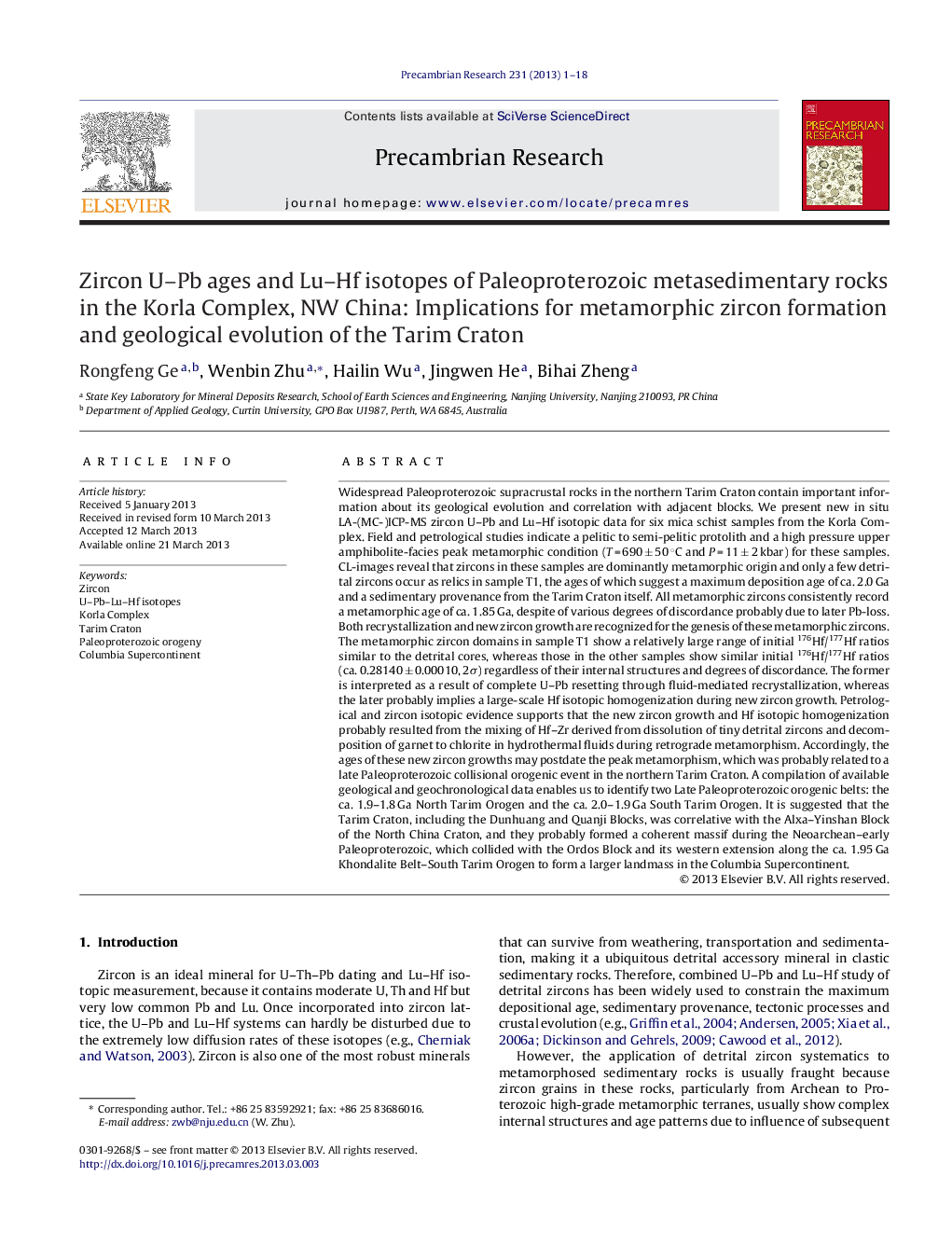| کد مقاله | کد نشریه | سال انتشار | مقاله انگلیسی | نسخه تمام متن |
|---|---|---|---|---|
| 4723206 | 1639643 | 2013 | 18 صفحه PDF | دانلود رایگان |

• The maximum depositional ages and metamorphic ages of supracrustal rocks are determined.
• Complete recrystallization and new zircon growth with Hf isotopic homogenization are found.
• Two Paleoproterozoic orogenic belts: the North and South Tarim Orogens, are inferred.
• A South Tarim Orogen–Khondalite Belt correlation is proposed for the Columbia reconstruction.
Widespread Paleoproterozoic supracrustal rocks in the northern Tarim Craton contain important information about its geological evolution and correlation with adjacent blocks. We present new in situ LA-(MC-)ICP-MS zircon U–Pb and Lu–Hf isotopic data for six mica schist samples from the Korla Complex. Field and petrological studies indicate a pelitic to semi-pelitic protolith and a high pressure upper amphibolite-facies peak metamorphic condition (T = 690 ± 50 ̊C and P = 11 ± 2 kbar) for these samples. CL-images reveal that zircons in these samples are dominantly metamorphic origin and only a few detrital zircons occur as relics in sample T1, the ages of which suggest a maximum deposition age of ca. 2.0 Ga and a sedimentary provenance from the Tarim Craton itself. All metamorphic zircons consistently record a metamorphic age of ca. 1.85 Ga, despite of various degrees of discordance probably due to later Pb-loss. Both recrystallization and new zircon growth are recognized for the genesis of these metamorphic zircons. The metamorphic zircon domains in sample T1 show a relatively large range of initial 176Hf/177Hf ratios similar to the detrital cores, whereas those in the other samples show similar initial 176Hf/177Hf ratios (ca. 0.28140 ± 0.00010, 2σ) regardless of their internal structures and degrees of discordance. The former is interpreted as a result of complete U–Pb resetting through fluid-mediated recrystallization, whereas the later probably implies a large-scale Hf isotopic homogenization during new zircon growth. Petrological and zircon isotopic evidence supports that the new zircon growth and Hf isotopic homogenization probably resulted from the mixing of Hf–Zr derived from dissolution of tiny detrital zircons and decomposition of garnet to chlorite in hydrothermal fluids during retrograde metamorphism. Accordingly, the ages of these new zircon growths may postdate the peak metamorphism, which was probably related to a late Paleoproterozoic collisional orogenic event in the northern Tarim Craton. A compilation of available geological and geochronological data enables us to identify two Late Paleoproterozoic orogenic belts: the ca. 1.9–1.8 Ga North Tarim Orogen and the ca. 2.0–1.9 Ga South Tarim Orogen. It is suggested that the Tarim Craton, including the Dunhuang and Quanji Blocks, was correlative with the Alxa–Yinshan Block of the North China Craton, and they probably formed a coherent massif during the Neoarchean–early Paleoproterozoic, which collided with the Ordos Block and its western extension along the ca. 1.95 Ga Khondalite Belt–South Tarim Orogen to form a larger landmass in the Columbia Supercontinent.
Figure optionsDownload as PowerPoint slide
Journal: Precambrian Research - Volume 231, July 2013, Pages 1–18